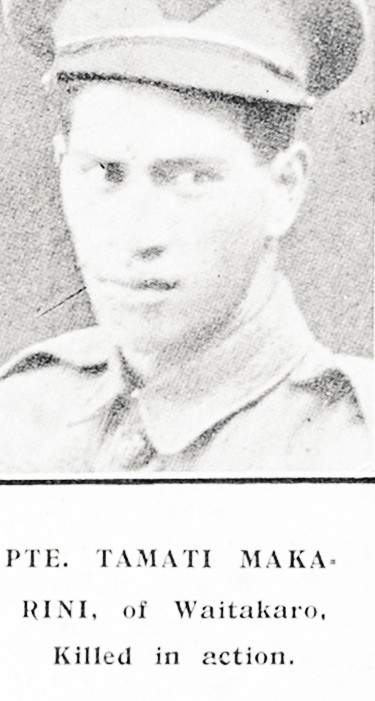Pte
Thomas (Tamati) McLean (Makarini)
Information about birth
|
Year of birth: 1893 |
|
Place of birth: Omaio, Bay of Plenty, New Zealand |
General information
|
Last known residence: Opotiki, Bay of Plenty, New Zealand |
|
Profession: Bushman |
|
Religion: Church of England |
Army information
|
Country: New Zealand |
|
Force: New Zealand Expeditionary Force |
|
Rank: Private |
|
Service number: 19728 |
|
Enlistment date: 15/01/1917 |
|
Enlistment place: Opotiki, Bay of Plenty, New Zealand |
|
Units: — New Zealand Maori (Pioneer) Bn. (Last known unit) |
Information about death
|
Date of death: 17/12/1917 |
|
Place of death: Polygon Wood, Zonnebeke, Belgium |
|
Cause of death: Killed in action (K.I.A.) |
|
Age: 24 |
Cemetery
|
Buttes New British Cemetery, Polygon Wood Plot: XII Row: AA Grave: 1 |
Distinctions and medals 2
|
British War Medal Medal |
|
Victory Medal Medal |
Points of interest 4
| #1 | Place of birth | ||
| #2 | Last known residence | ||
| #3 | Enlistment place | ||
| #4 | Place of death (approximate) |
My story
Tamati Makarini was born in Omaio, Bay of Plenty, New Zealand, in 1893. He was the son of Puhata and Heneriata Makarini. His name was anglicised to Thomas McLean. Tamati worked as a bushman near Opotiki and was briefly married to Mate. In late 1915, they had a child they named Ka.
In January 1917, he enlisted, never to return to his family and the Bay of Plenty. After training at Narrow Neck Camp in Auckland, the training camp for Pioneer Battalion recruits from iwi and Pacific islanders, he left New Zealand in April 1917. In France, he was posted to the Maori Pioneer Battalion.
The Pioneer Battalion supported the New Zealand Division by building roads and railways, digging trenches and performing the many physical tasks required in static warfare. This could include front-line work as well as work behind the lines.
After the end of the Battle of Passchendaele, the New Zealanders found themselves in the Polygon Wood area. Much time was spent wiring, repairing crumbling trenches and improving defences. The landscape was covered with waterlogged shell holes. German forces generally held higher ground and movements in the New Zealand lines were often observed and then shelled or machine-gunned.
During this time, the Pioneer Battalion worked on a tramway to Crucifix, a dump at The Butte, duck-board tracks from Polygon Wood to Black Watch Corner and a communication trench from Polygon Butte to the front line at Jolting Houses, east of Polgon Wood. In December, the weather was often freezing, making ground work difficult. German shelling was heavy, affecting both the front line and the areas behind.
Tamati, 24, died of his wounds in the field on 17 December 1917. His burial in the makeshift cemetery near the Butte was reported by chaplain Clive Mortimer-Jones. Today, his exact grave is not known. Tamati has a special memorial at Buttes New British Cemetery, plot XII, row AA, grave 1, which reads 'Believed to be buried in this cemetery'.
In January 1917, he enlisted, never to return to his family and the Bay of Plenty. After training at Narrow Neck Camp in Auckland, the training camp for Pioneer Battalion recruits from iwi and Pacific islanders, he left New Zealand in April 1917. In France, he was posted to the Maori Pioneer Battalion.
The Pioneer Battalion supported the New Zealand Division by building roads and railways, digging trenches and performing the many physical tasks required in static warfare. This could include front-line work as well as work behind the lines.
After the end of the Battle of Passchendaele, the New Zealanders found themselves in the Polygon Wood area. Much time was spent wiring, repairing crumbling trenches and improving defences. The landscape was covered with waterlogged shell holes. German forces generally held higher ground and movements in the New Zealand lines were often observed and then shelled or machine-gunned.
During this time, the Pioneer Battalion worked on a tramway to Crucifix, a dump at The Butte, duck-board tracks from Polygon Wood to Black Watch Corner and a communication trench from Polygon Butte to the front line at Jolting Houses, east of Polgon Wood. In December, the weather was often freezing, making ground work difficult. German shelling was heavy, affecting both the front line and the areas behind.
Tamati, 24, died of his wounds in the field on 17 December 1917. His burial in the makeshift cemetery near the Butte was reported by chaplain Clive Mortimer-Jones. Today, his exact grave is not known. Tamati has a special memorial at Buttes New British Cemetery, plot XII, row AA, grave 1, which reads 'Believed to be buried in this cemetery'.
Sources 2
|
Archives New Zealand https://archway.archives.govt.nz/ Sources used |
|
Cowan J., The Maoris in the Great War : a history of the New Zealand Native Contingent and the Pioneer Battalion, (Auckland, Whitcombe & Tombs, 1926), p.126-128. Sources used |
More information 5
|
Commonwealth War Graves Commission Database https://www.cwgc.org/find-records/find-war-dead/casualty-details/480352 |
|
Namenlijst (In Flanders Fields Museum) https://namenlijst.org/publicsearch/#/person/_id=18e2458a-ab53-49b5-9d2c-927254f087c0 |
|
Lives of the First World War (Imperial War Museum) https://livesofthefirstworldwar.iwm.org.uk/lifestory/7179141 |
|
The NZEF Project (UNSW Canberra) https://nzef.adfa.edu.au/showPerson?pid=171277 |
|
Online Cenotaph (Auckland Museum) https://www.aucklandmuseum.com/war-memorial/online-cenotaph/record/c9950 |
